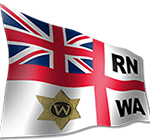TO THE WEST INDIES AND BACK AGAIN
(……………well, not quite!!!)
Fwd by Don McGeorge, RNWA Membership Secretary
As a part of our intention to promote and celebrate the events and achievements that our branch members have been involved in, which are normally under reported publicly and played down individually, this is the first of an occasional series of articles to reverse that. Michael “Dixie” Deans, then a CPOWtr in HMS PLYMOUTH, charts the background to his joining that ship, and the detailed history – from his perspective – of its time in the Falklands conflict, including the most iconic photograph of that time – in which he is very obviously bang in the middle!
Read on – this is a thoroughly engaging and moving account of a time that we all hope is never repeated. Thank you Dixie!
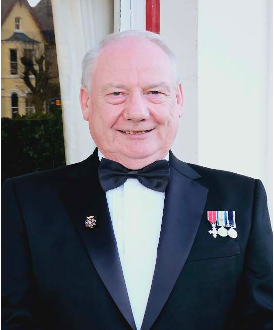
This is an account of my first sea draft as a Senior Rate to a ship in deep refit in the depths of Winter, in a place many of you will – at that time – have been very familiar with, from being a Chief to PO and back again (not for what you are thinking!!), a sea draft that was to culminate in 4 months in the Caribbean as West Indies Guardship during the Spring of 1982 – that didn’t really turn out as planned!
Being a Writer in the early 70s (I joined up as a Junior Assistant Writer 2nd Class on 31 August 1971) was, I’m certain, very different to those who will have served before me and certainly those who served after I left the Service (in April 1996).
During the 70s, advancement in the branch could be very rapid, so long as you passed your verbal Provisional Professional Examination (PPE), then passed the LWtr or POWtr courses at the RNSS in Chatham. I wasn’t one for hanging about, I passed all the relevant courses including PO’s Leadership Course at HMS ROYAL ARTHUR, and somehow found myself becoming Acting Local Chief Writer in HMS NEPTUNE on 10 August 1979 – the day after my 25th birthday, less than 8 years after I had joined up. I did meet my wife during this time. She was a Wren Wtr working in the Education Office and then down in the Ops Room – fortunately no conflict of being in same office! Interestingly, Barbara was from Wigan and I mentioned that I had joined up in 1971 with a Wigan lad, and we had been through Raleigh and Pembroke together as we were in the same branch – his name was Norman Prior. It transpired that Norman’s dad and Barbara’s mum were brother and sister – so Norman and me became related and, to add further branch interest from that period, we were promoted to WOWtr at the same time!
Getting from my first draft after completing training in February 1972 as an Assistant Writer in HMS NEPTUNE Pay Office to that day in 1979 was not without its own stories…..but they are for another day!
After 14 months as Acting Local Chief Writer, I was drafted in Oct 1980 as a POWtr to HMS PLYMOUTH. I always knew that I’d have to get back into PO’s rig – but it was a tough gig. Not the draft, but I joined her in Chatham Dockyard and all the crew were still living ashore in PEMBROKE barracks – full circle!! The ship was going to be based in Rosyth, so we also had to accommodate a Married Quarter move from Faslane to Rosyth at the same time.
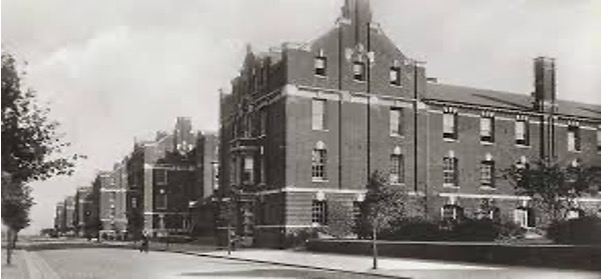
Everything will be fine!
Everything will be fine when I get down to Chatham, I said to myself. Then again, maybe not!!
It was the coldest Winter for many years, the seamen were scraping ice off the guardrails most mornings, and when I found the Ships Office it was bare……. empty cupboards, no furniture, no keys to the safe, no staff, nothing!! Last week I was Centre Desk Chief Writer in one of the largest Pay Offices in the Navy, and now to this. Anyway, onward and upwards.
My abiding memories of those early days in Chatham…..
- Where were you when John Lennon was shot – I was walking to breakfast in the POs Mess, Pembroke Barracks.
- Weekends back up by hired car to Rosyth, sometimes in vehicles that would only pass an MOT if you had a vivid imagination.
- The PO(GI) marching us back up from the ship late one evening to Pembroke – after we had our first delivery of CSB into the Fwd POs Mess onboard.
- The same PO(GI) organizing raiding parties to HMS SALISBURY that was being disposed of to find anything we could that would make our life onboard more comfortable. Joining an old ship coming out of refit with not a long life left in her, it was obvious that not a great deal was being spent on her. Raiding SALISBURY, even if it was screwed down! If it was wooden, and we could decorate our Mess with it, we took it. We renamed the Mess bar the ‘Screw It Inn’ for obvious reasons. Naming the bar in the Mess was like a game, finding the best one. Best I ever saw was POs Mess HMS RHYL – the ‘Feel Crappers and Turners Inn’ – genius!!
Oh, and we found the keys to the safe, furniture started arriving, all the BRs, etc eventually arrived, and the office started to look something like well – an office! John Bain and Kevin Doherty had joined as my Wtrs and Commissioning Day finally arrived, on a Saturday in January 1981, so that spoiled that weekend. We were to be Captain F6 – we called ourselves the Flag Ship of the Scottish Navy, and we thought we’d all be back in Rosyth soon. We were, but not for long – we had to complete BOST. Deep Joy – as I’m sure many of you will recall with “fond” memories.
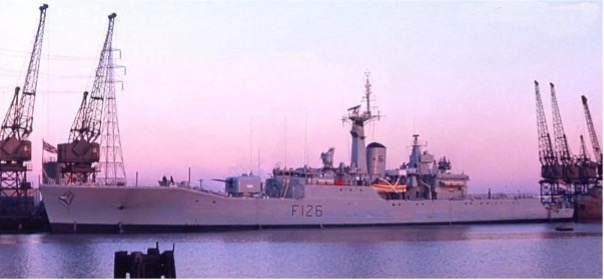
Eventually, BOST was completed, maybe not, as a whole ship as successful as others (short anecdote later) – and weekends to Rosyth from Portland were even more eventful than from Chatham……Gordano Services on the M5 had just opened and were very posh at the time – but the selection of motors to make the long journey north had certainly not improved.
The rest of 1981 did bring some delightful runs ashore – Brest, Malmo……and Newcastle. You can guess for yourself what was the most memorable out of those 3 visits. Newcastle was closest to Rosyth!!! While we were doing FCS1 (24 hours’ notice) from Rosyth, we were allowed shore leave to anyone as far south as Newcastle/Carlisle areas. Didn’t quite work out well as we were tasked to sail Sunday morning from Rosyth and recall began at 5pm Saturday evening. Needless to say, not everyone made it back in time and we shadowed the Russian carrier KIEV all the way to North Cape with 60% ships company onboard. At least the NAAFI queue was short and, fortunately, the North Atlantic was remarkably calm the whole journey north and back again.
Eventually, 1982 came and we had so much to look forward to…..we were to become West Indies Guardship in May. Fun in the Sun. I still have a copy of the Longcast – AMP in Rosyth most of Jan, visit to London in Feb, back to Rosyth for Leave, and sail on 15th March 82 for Gibraltar and Exercise Springtrain. On completion of Springtrain, AMP in Gibraltar for 2½ weeks, then sail for West Indies and visits to Martinique, Dominica, Montserrat, British Virgin Islands, Belize, Key West, 3 weeks SMP in St. Petersburg, Bahamas, Bermuda and back to Rosyth for the end of July. Well, that was the planned programme!!
We sailed from Rosyth on 15th March as planned with flip flops, sunglasses, sun cream, golf clubs and shorts (we were off to the West Indies) and it was the day after we sailed that I was promoted to Chief Writer but, as I was in a PO’s billet, there was no bed for me in the Chiefs Mess and I had to remain billeted in the Fwd PO’s Mess. That was awkward as I obviously had full access to both Messes. But the simple things – where do I go for Stand Easy; where do I spend evenings; do I go to the Chief’s Mess and just back to the PO’s Mess as that was where my bunk was. It was a credit to my colleagues that everything was accepted, no matter what choice I made on any day. After a few weeks, I realized that I had to spend as much time in the Chiefs Mess as possible and just sleeping in the Fwd POs Mess was the best option for both myself and my colleagues (and friends) in the Fwd POs Mess.
Exercise Springtrain Cancelled!
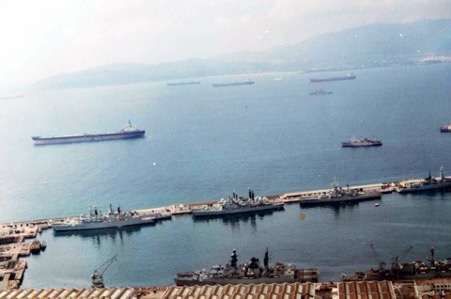
It was during Exercise Springtrain that everyone started hearing about General Galtieri and the Falkland Islands. But it was also during Springtrain that HMS Plymouth’s Ships’ Company came together as one complete team, regardless of which mess you belonged to – and related to Sport. Over a few days, we entered our best teams in every event of the Midi-Ships Cup. Top of the Rock Race, Hockey, Football and between our Clubswinger and myself we made sure we were well supported at every event. If you weren’t watchkeeping, runs ashore were for the evenings. By the last day, if we won Tug of War, we would win the Midi-Ships Cup. We knew we could do it as we had a good run the previous year in Rosyth and the cry of “Down and up; Down and up” was the way to beat anyone just pulling against you with brute strength. We did win but, more importantly, we had the full support of most of the crew and we didn’t yet know the effect those few days would have on us all.
Argentina and the Falkland Islands was now beginning to take over everyone’s thoughts and Exercise Springtrain was cancelled. HMS PLYMOUTH, along with HMS ANTRIM, were the first ships tasked to sail south not yet knowing what was expected of us or if our West Indies Guardship trip was about to be taken from us. I guess the crew of HMS ROTHESAY knew before we did as they eventually took our place for ‘Fun in the Sun’!
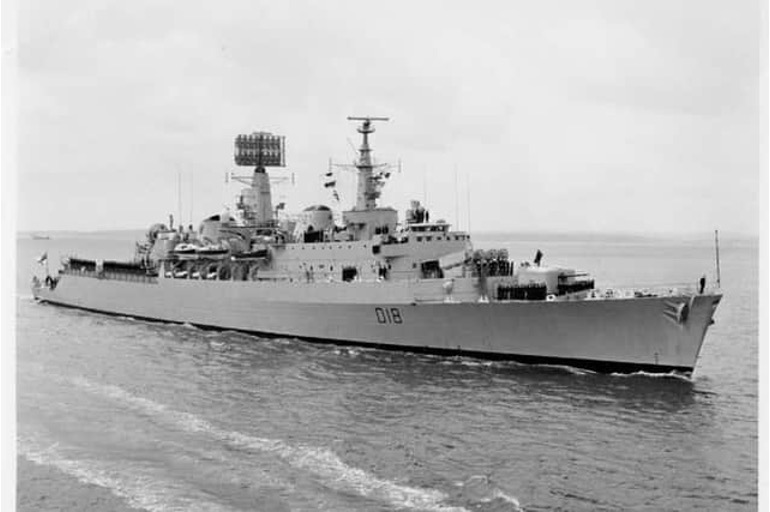
I kept a, mostly non-personal, diary of the events of HMS PLYMOUTH’s involvement and could find no better way than sharing that diary with you, together with some other information that I have found out about later, sometimes the same day, some much later, even many years later. I’ve used this additional information to give more detail to the reader about events both onboard, afloat and ashore.
It is worth mentioning before reading the Diary that being between decks during Action Stations – most days during the main part in San Carlos Water from 10.30am until 8pm, with Action Messing around lunchtime – was uneventful. Whoever said that ‘War was 90% boredom and 10% sheer terror’ was not far wrong!
I’m certain that some of you reading my Diary will have other experiences, especially in those ships that were also damaged or, tragically, lost. And I would like to you all to remember, and never forget, the one member of the Branch who ‘remains on patrol’……
RIP to Chief Petty Officer Writer Edmund ‘Ted’ Flanagan – killed in action onboard SS Atlantic Conveyor on 25TH May 1982. Some of you may know that in 2022, as part of the Falkland Islands 40th Anniversary Place Names Project, ‘Ted’ was honoured with ‘Flanagan Bay’, a bay on the north shore of Ruggles Bay on the Falkland Sound side of East Falkland.
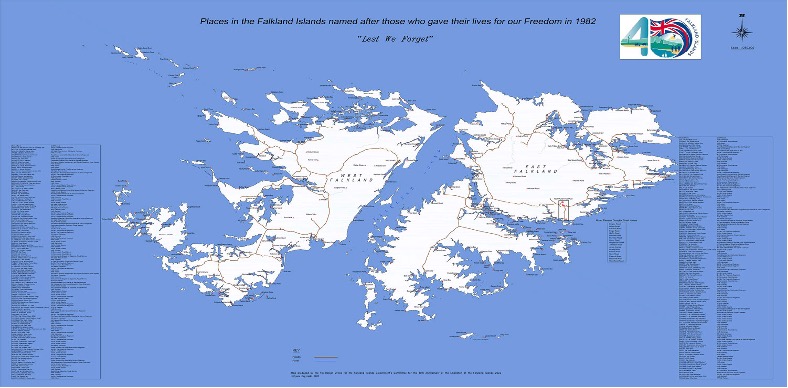
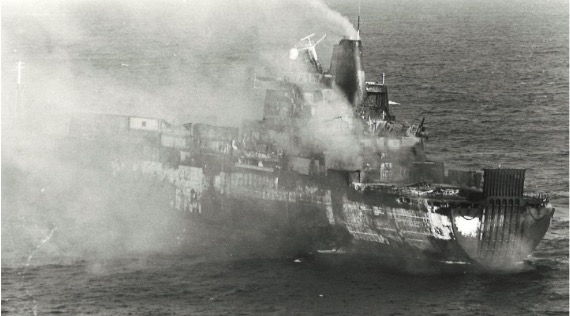
Enjoy the Diary. I would respectfully request that you do not share its contents on any other social media platform.
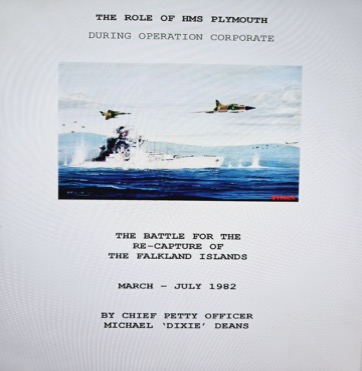
Task Force
BRITISH MILITARY UNITS TAKING PART
Royal Navy Warships (D) = Damaged (L) = Lost
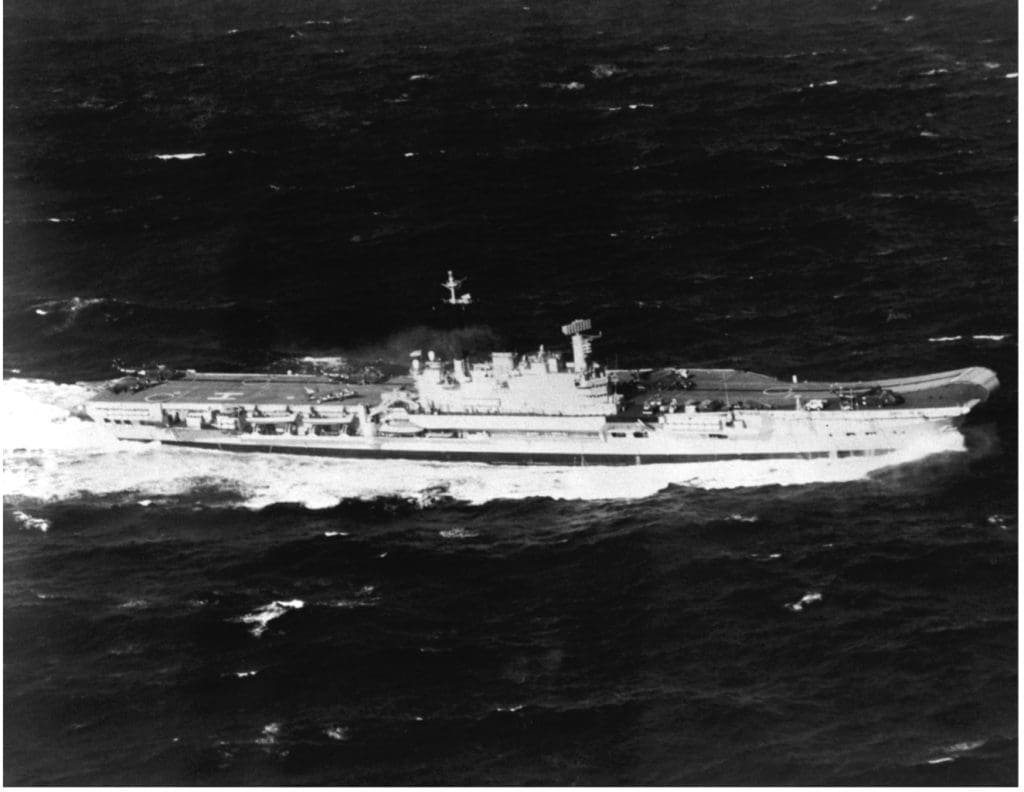
Aircraft Carriers:
HERMES
INVINCIBLE
Destroyers:
Frigates:
ARDENT(L) ARGONAUT(D) ANTELOPE(L) AMBUSCADE ACTIVE AVENGER ANDROMEDA MINERVA PENELOPE
Ice Patrol Ship:
ENDURANCE
Submarines:
Troop Transports:
Aircraft Support Ship:
ATLANTIC CONVEYOR(L)
Royal Fleet Auxiliary Ships:
RFA Tankers:
Tankers:
Water Tanker:
FORT TORONTO
Fleet Air Arm
Carrier Aircraft:
Other Helicopters:
Land Forces
Transport Ships:
Other ships and Helicopter Squadrons in Falklands Area
Hospital Ship
Uganda
Ambulance Ships
Repair Ship
Stena Seaspread
Tugs
RFAs
Merchantmen
Requisitioned Minesweepers
RFA Tanker
Blue Rover
RMAS Tug
Typhoon
Despatch Ships
Ammo Ship
Lycaon
Stores Ship
Saxonia
Royal Air Force (operating from Ascension Island)
VC 10 transports of 10 Sqdn
Hercules transports of 24, 30, 47 and 70 Sqdns
Nimrod maritime reconnaissance aircraft of 42(TB), 120, 201 and 206 Sqdns
Victor tankers of 55 and 57 Sqdns
Vulcan bombers of 44, 50 and 101 Sqdns
Harrier GR 3 attach aircraft of 1(F) Sqdn
Chinook helicopter of 18 Sqdn and
Sea Kings of 202 Sqdn.
Phantom fighters of 29(F) Sqdns
and Units of RAF Regiment
OPERATION CORPORATE
THE ROLE OF HMS PLYMOUTH, DIARY OF EVENTS APRIL – JULY 1982
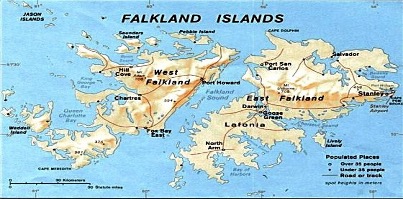
On Tuesday 16 March, a party of 36 Argentinian Scrap Metal Merchants landed at Leith on the island of South Georgia, a dependency of the Falkland Islands. They refused to comply with the requests of the British authorities at Grytviken to complete the necessary paperwork to legalise their landing and raised the Argentinian flag. So heralded the invasion of South Georgia and the Falkland Islands by the Argentinian Armed Forces on Friday 2nd April 1982. The British Government’s reaction to this invasion was staggering – the largest naval force since the Suez crisis (1956) was ordered to sail for the South Atlantic.
Aware that an invasion was imminent, Exercise Springtrain was abandoned on Thursday 1st April and the majority of naval units involved were ordered to proceed south. The main task force, led by HERMES and INVINCIBLE, sailed from the UK on Monday 7th April.
Friday 2 April
PLYMOUTH, together with ANTRIM (as CTG) and RFA TIDESPRING (Troop Carrier), was ordered to detach from the ‘Springtrain Group’ and proceed south at speed towards Ascension Island. From this order, and the introduction of mail censorship onboard, speculation among the ships’ company arose as to the reasons behind it. The consensus of opinion was that the ship might be involved in early action and the re-taking of South Georgia to set up a forward operating base was much discussed.
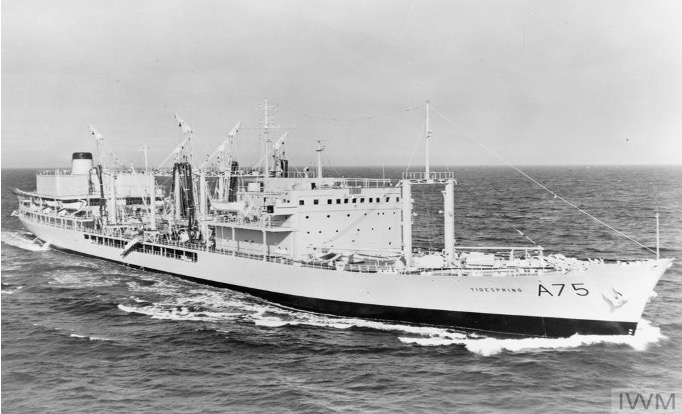
Saturday 3 April – Friday 9 April
This period was spent on passage southwards towards Ascension Island. Compulsory keep-fit was held daily on the flight deck and food rationing was introduced to conserve our supplies. A great deal of intensive training was also undertaken to prepare for what may lie ahead. War Orders were hastily drafted. Seaman’s Wills were filled out. Letters to loved ones and family were written – difficult as we were heading to a conflict that was not anticipated when we left Rosyth on 15th March. I even joined the Royal Navy Writers Association – this must be for real. The radio was listened to intensely (no Sky News or mobile phones in those days) to see if political talks at averting a conflict were in anyway successful. The BBC World Service theme tune is something I’ll never forget!! Complete radio and radar silence was maintained throughout the passage southwards. Crossing the Equator did not result in a visit from King Neptune. We were told he would visit us on our return voyage!!
Saturday 10 April
PLYMOUTH, ANTRIM and TIDESPRING arrived at Ascension Island, accompanied by SHEFFIELD who had also joined the group. A major transfer of stores and personnel began. We also embarked an Army Warrant Officer NGS (Naval Gunnery Support) Specialist and he very quickly adapted to life onboard. He was also very well briefed (although he couldn’t share this information immediately) on what was likely to happen over the next few weeks. One of the Chiefs had been landed at Ascension for family reasons and the Army WO got a bunk in the Mess.
Sunday 11 April
On completion of the transfers, PLYMOUTH, ANTRIM and TIDESPRING were ordered to continue the passage south. SHEFFIELD remained behind at Ascension Island awaiting the arrival of the main Task Force.
Monday 12 April
We settle down again into a series of keep fit and drills for an operation we all secretly hope will not take place. It’s still 4000 miles to the Falklands. And we remain glued to the BBC World Service.
Tuesday 13 April
PLYMOUTH carried out a major RAS(S) with RFA FORT AUSTIN (below) and on completion of this RAS we were officially told of our mission – to re-capture South Georgia on behalf of Her Majesty’s Government.
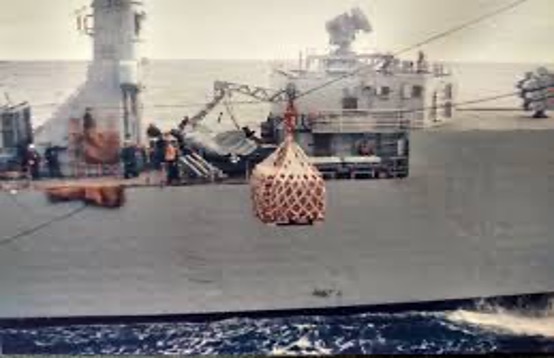
OPERATION PARAQUAT – SOUTH GEORGIA
Wednesday 14 April
We also begin conducting anti Exocet drills. Just the word ‘Exocet’ brought a feeling of dread. I was to learn later that part of our defence would mean the starboard quarter of the ship would most likely be the target facing any incoming missile. My Action Station as First Aid Party was in the starboard section! Continuing to listen at every opportunity to the radio, the BBC World Service had made no mention of South Georgia.
Thursday 15 April
Our Army WO colleague is interviewed on the ship’s broadcast system to explain who he is and what 148 Cdo Battery are and what they do. He also described what it was like when the main Task Force sailed out of Portsmouth. We had no idea of what that looked like.
Friday 16 April (my daughter’s 2nd birthday)
We meet up again with FORT AUSTIN who was on her way back to Ascension Island having completed a RAS with ENDURANCE. She also now has a Squadron of SAS onboard who transfer to ANTRIM and PLYMOUTH. It was at this time that we also had to begin some ‘hot-bunking’ as there were no spare bunks. It was obvious that our keep-fit sessions on the flight deck would never turn us into SAS soldiers – some of the training they did, like one-armed push-ups, was beyond most of the PLYMOUTH crew!
Saturday 16 April
Today we met up with ENDURANCE who has sailed north to get out of bad weather. She was welcomed by the crews of our 3-ship group and we lined the upper decks to give her a big cheer. Quite an emotional day (there were a few of them to come) and the ships’ company of ENDURANCE must have felt very relieved as we were the first warships she has seen for a long time and she must now have felt well protected. The 4-ship group continued to proceed towards South Georgia, hopefully undetected. A second group of ships, COVENTRY, GLASGOW, SHEFFIELD, BRILLIANT and ARROW had also now sailed south from Ascension Island, and this group was to cover our passage towards South Georgia by sailing between ourselves and any possible enemy surface or sub-surface units should they sail from Argentina.
By this time the British Government had declared that a 200-mile Maritime Exclusion Zone had been set up around the Falkland Islands, being enforced by at least one of our nuclear submarines. Argentina had countered this by setting up her own 200-mile exclusion zone around the Falkland Islands and had also included the dependencies of South Georgia and the South Sandwich Islands.
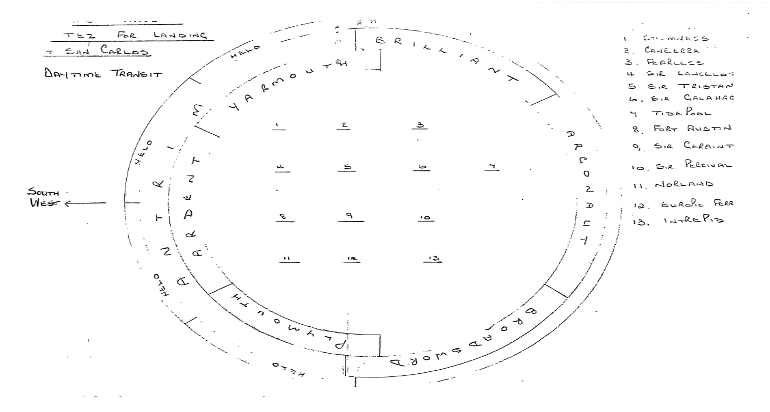
Monday 19 April
The Task Group enters the 200-mile exclusion zone of South Georgia and Defence Watches were introduced.
Wednesday 21 April
Official confirmation was received that Operation Paraquat – the re-capture of South Georgia was to go ahead as planned. ANTRIM landed two recce patrols by helicopter to the north of Grytviken and ENDURANCE landed two patrols to the south. Later that day, we heard on the BBC World Service that some papers in the UK were carrying a story about our mission. It was speculation as the article had reported ‘Destroyers, aircraft carriers and troopships were said to be speeding towards the remote outpost’. However, we did feel a bit betrayed as we had come so far, undetected. (Note…this would not be the first time the BBC informed the world of issues that did not favour the UK forces).
Thursday 22 April
The recce patrol of SAS that had been landed to the north of Grytviken on Fortuna Glacier had encountered atrocious weather conditions and they requested assistance to be picked up. Two Wessex 5 helicopters from TIDESPRING were despatched to rescue this patrol and they both crashed in white-out conditions. Both crews survived and a Wessex 3 from ANTRIM finally rescued both them and the SAS patrol.
Friday 23 April
The force was overflown by an Argentinian Hercules reconnaissance aircraft and, although PLYMOUTH did fire a missile – the first shot of the whole operation – the aircraft did not come close enough and departed the area. Reports of an enemy submarine in the area caused the Task Group, excluding ENDURANCE, to retreat outside of the 200 mile exclusion zone. BRILLIANT now joined the group to lend assistance to our ASW (Anti-Submarine Warfare) capabilities.
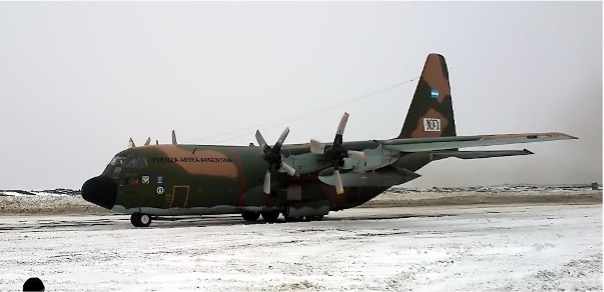
Saturday 24 April
ENDURANCE had reported sighting the Argentinian submarine SANTA FE in the area and it was assumed that she had landed more troops to reinforce the garrison now on the island. Late that evening, the Task Group commenced a high-speed approach towards South Georgia. Morale onboard the ship is high.
Sunday 25 April
At 0930, PLYMOUTH, with her battle ensign hoisted, went to Action Stations as the SANTA FE (below) had been sighted on the surface. She had been damaged some 15 minutes earlier by a Lynx helicopter from BRILLIANT and was holed in her conning tower and reportedly heading for Grytviken. At 1030, helicopters from PLYMOUTH, BRILLIANT and ENDURANCE fire rockets at the submarine – PLYMOUTH’s Wasp helicopter reported a direct hit in the after section of the submarine. We now realise that we are at war. At 1100, the SANTA FE entered West Cumberland Bay and put alongside the jetty at King Edward Point and was listing badly. Although the attacks only slightly damaged the submarine and wounded one crewman, she was abandoned by noon. Later, on being moved to Grytviken, one crewman was shot and killed in the mistaken belief that he was trying to scuttle the boat.
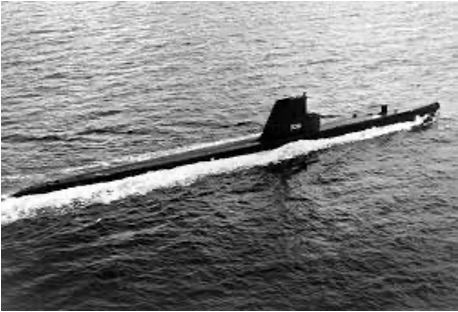
As it was anticipated that the enemy force might now number in excess of 140, ENDURANCE lands a Naval Gunfire Observer (NGO) onto the island. PLYMOUTH and ANTRIM then closed the island around the area of Grytviken to carry out NGS (Naval Gunfire Support) to the small force of SAS and SBS that were landed on the island by ANTRIM’s Wessex and BRILLIANT’s two Lynx helicopters. Shortly after 1400, the NGO ashore ordered both ships to direct fire onto enemy gun position and onto Brown Mountain. One ship on each target. PLYMOUTH opened fire moments before ANTRIM, so becoming the first warship in a long time to engage the enemy. Over the next two hours, PLYMOUTH fired 166 4.5inch shells around enemy positions in Grytviken. The two ships also prepared to land more troops ashore, although PLYMOUTH’s contingent of SAS were not required as, at 1700, the Argentinians surrendered with no shots being fired.
When contacted by radio, a small detachment of Argentinian marines at Leith, under the command of Lt Cmdr Astiz refused to surrender. At 2000, PLYMOUTH and ENDURANCE enter Cumberland Bay and landed 12 SAS personnel to end the occupation of South Georgia. As our 4.5 gun is still loaded, we clear them into the Glacier behind Leith and at 2200, the Argentinians radio that they will surrender at 0900. The Union Flag was now proudly flying alongside the White Ensign on South Georgia.
PLYMOUTH departed Cumberland Bay overnight to conduct ASW patrol around the area.
Monday 26 April
PLYMOUTH re-entered Cumberland Bay and at 0930 PLYMOUTH informs ANTRIM that Leith is now secure, but heavily booby trapped and mined. The battle for South Georgia is now over with only two injuries. One was a submariner who was shot accidentally by an RM guard when he attempted to meddle with the internal gauges and a RN medic who sprained his ankle when he jumped out of a helicopter. The Commander of the forces in Leith, Lt Cmdr Astiz, was invited on board to officially surrender South Georgia. The photograph of the Leith surrender ceremony in the Wardroom of HMS PLYMOUTH received worldwide publicity. It was to be discovered later that Lt Cmdr Astiz was very infamous in the eyes of France, Sweden, the Red Cross and Amnesty International. He was known as ‘the Executioner’ because of the atrocities he had committed in Argentina over the previous few years. 200 Prisoners of War were taken and some 150 ended up onboard PLYMOUTH. Being very dirty and smelling somewhat unpleasant, it was a relief to eventually transfer them to TIDESPRING for onward routing to Ascension Island and repatriation to Argentina.
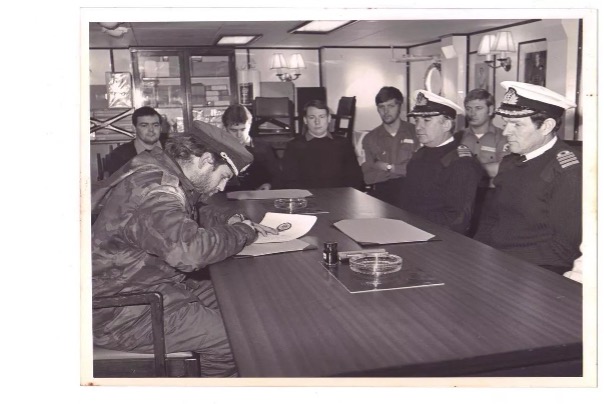
Tuesday 27 April
The day was spent transferring personnel between the five ships in the group. It was not yet known what PLYMOUTH’s next role would be. Would we remain in South Georgia or not?
Wednesday 28 April
The transfer of personnel was completed and late that afternoon PLYMOUTH, accompanied by BRILLIANT, was despatched from South Georgia to join the main Task Force.
Thursday 29 April
After a passage in extremely poor weather and visibility, the main Carrier Battle Group (CVBG) led by HERMES and INVINCIBLE was eventually located and it was at this time that we had our first impression of how large the Task Force was to become. HERMES, INVINCIBLE, GLAMORGAN, BRILLIANT, BROADSWORD, ARROW, YARMOUTH, ALACRITY, SHEFFIELD, GLASGOW plus some RFAs. It was quite a site. The day was again spent transferring stores, personnel and mail. It was still expected that PLYMOUTH would be returning to South Georgia to relieve ANTRIM, who was due to escort TIDESPRING back to Ascension Island.
Friday 30 April
A day spent by most ships conducting both RAS(L) and RAS(S) – Replenishments at Sea (Liquid) and (Stores). The anticipation that something very spectacular was about to begin grew among the ship’s company.
Saturday 1 May
A lone Vulcan bombing raid on Port Stanley airfield heralded a very busy day for all of the ships in the CBG. The Vulcan had taken off from Ascension Island late the previous day, supported by eleven Victor tankers for in-flight refuelling. (It is worth reading the full story of Operation Black Buck in detail from other sources). At 0800, the airfield was attacked and this was followed by further raids carried out by Sea Harriers from HERMES and INVINCIBLE. The ship remained at Action Stations for most of the day and at 2100 we were ordered to return to South Georgia. Shortly after leaving the CBG, a possible submarine was detected. Firing 15 Mk10 Mortars at the ‘enemy’, we succeeded in causing some serious damage to a school of whales!!
Monday 3 May
During our return passage to South Georgia, reports were received of the first major ship loss of the war – the Argentinian cruiser GENERAL BELGRANO had been attacked by one of our nuclear submarines and sunk. The submarine was not named at that time but was later reported as CONQUEROR. The attack on the BELGRANO had taken place the previous evening. It was a very sombre ship’s company for most of that day as we were now beginning to realise the very real dangers to be faced by all at sea.
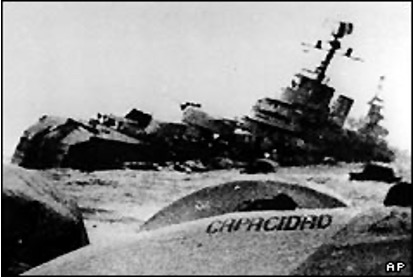
Tuesday 4 May
The sinking of the BELGRANO had a major effect on the Argentinian Navy and it was reported that all of her ships were returning to port. They were not to sail again during the conflict. However, the Argentinian Air Force proved to be a formidable enemy and the Task Force suffered her first major loss of the war. Operating some 70 miles to the south-east of Stanley, the CBG comes under attack from 2 Super Etendards each carrying an Exocet AM39 missile. At 1100, both aircraft fire their missiles and SHEFFIELD was hit with very little warning. The other missile was reported to have narrowly missed our sister ship, YARMOUTH, before falling harmlessly into the sea.
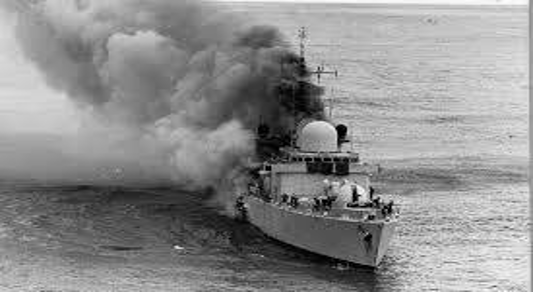
Badly damaged, with little power and uncontrollable fires, SHEFFIELD (above) was eventually abandoned later that afternoon. 20 men had been killed. She eventually sank five days later.
A note of interest – as the British Media were being starved of information from the Ministry of Defence, it was later reported in the press that PLYMOUTH had narrowly escaped during the sinking of SHEFFIELD. The Argentinians had made the claim and the press picked up on the news, although it had been our sister ship YARMOUTH that was in the vicinity.
Wednesday 5 May
Our ‘return passage’ to South Georgia was abruptly cut short. PLYMOUTH was ordered to proceed north towards Ascension to rendezvous with the ships of the Amphibious Group, led by FEARLESS and INTREPID, carrying the Marines and Army units of 3 Commando Brigade. It was to be our duty to provide escort duties back down to the Falklands. The next three days were spent in a very relaxed atmosphere and the temperatures became much more enjoyable as we proceeded north.
Saturday 8 May
We continued north and the highlight was a stores and mail drop by a Hercules transport aircraft from Ascension Island. This consisted of several low level passes, dropping loads by parachute and retrieving them from the sea by helicopter, Sea Rider and Gemini.
Sunday 9 May
We rendezvoused with the LSL (Landing Ship Logistics) Group, carrying 3 Commando Brigade, who would spearhead any landing on the Falkland Islands. We were also joined again by ANTRIM who had now left TIDESPRING to continue her journey to Ascension Island in relatively safe waters. The period between I0 May and 16 May was spent on passage towards the Total Exclusion Zone (TEZ).
Wednesday 12 May
HMS PLYMOUTH’s 21st Birthday. A specially prepared cake was ceremoniously cut by Captain Pentreath and was enjoyed by all. A welcome break from the task in hand.
Sunday 16 May
All ships carrying the land forces of the Amphibious Group now came together 200 miles north east of Stanley to begin the redistribution of equipment, stores, men and helicopters in preparation for the expected landings on the Falkland Islands. Although the majority of ships in the Amphibious Group were Naval or Royal Fleet Auxiliary vessels, a major ship was also part of the group, the converted cruise liner, CANBERRA.
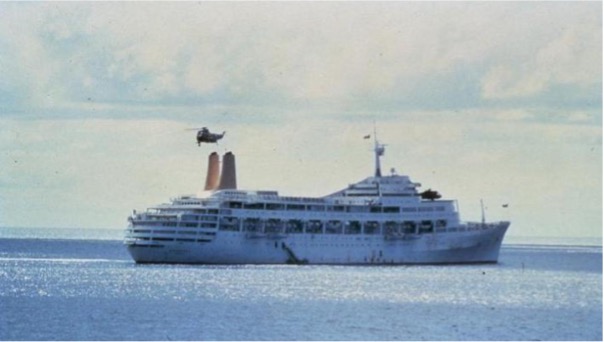
Monday 17 May
The redistribution of men and equipment continued unabated for the next three days in surprisingly calm weather for the South Atlantic. 40 Commando Royal Marines transferred to FEARLESS and elements of 45 Commando and 3 Para transferred to INTREPID. 42 Commando remained onboard CANBERRA and the rest of 45 Commando transferred to STROMNESS. 2 Para transferred to NORLAND.
Wednesday 19 May
During the final stages of the personnel transfers from HERMES to INTREPID, a Sea King helicopter loaded with SAS crashed into the sea with the loss of 21 of the 30 men onboard. A bird strike is thought to have brought the helicopter down. Some of those who were with us in South Georgia were among those killed. What a blow; what a waste.
OPERATION SUTTON -THE RECAPTURE OF THE FALKLAND ISLANDS
Thursday 20 May
In perfect weather – low cloud, high seas, wind and rain – the assault force headed for Falkland Sound. Led by the command ship FEARLESS, it consisted of INTREPID, five LSL’s (Sir’s LANCELOT, TRISTRAM, GALAHAD, GERAINT and PERCIVAL), the merchant ships CANBERRA, EUROPIC FERRY and NORLAND, and RFAs STROMNESS and FORT AUSTIN. The naval escorts of ANTRIM, ARDENT, ARGONAUT, BRILLIANT, BROADSWORD, PLYMOUTH and YARMOUTH accompanied them.
Friday 21 May
(To avoid confusion throughout the Operation, and receipt of messages from UK, all forces remained in Zulu time, so ‘daylight’ in the Falkland Islands didn’t break until around 10am each day, with nightfall around 8pm.)
Under cover of darkness and now in Falkland Sound, ANTRIM began a diversionary bombardment of the western island and landed a force of SAS to tackle an Argentinian force on Fanning Head at the entrance to San Carlos Water. This was eventually successful, and the landings began. At 0430, led by PLYMOUTH, the first warship, together with landing craft from FEARLESS and INTREPID carrying 40 Commando and 2 Para entered San Carlos Water and the troops landed completely unopposed. As daylight broke the landing craft returned to the ships still outside San Carlos Water to pick up the second wave of troops – most of 45 Commando and 3 Para. As the three beachheads around San Carlos were secured, the amphibious ships of the task force entered San Carlos Water in broad daylight. However, it was not long before the Argentinian response was made and their Air Force began sustained air raids into what became known as ‘Bomb Alley’. It also began a crucial battle for air supremacy over the islands.
PLYMOUTH spent most of the day patrolling around CANBERRA, our role to prevent any enemy aircraft from attacking her. A ‘nice’ assignment given that she presented the biggest target in San Carlos Water as well as being completely white! Five escort ships had remained in Falkland Sound and took especially heavy damage and casualties.
ANTRIM was hit by 14 cannon shells and had a UXB (unexploded bomb) onboard, and her missile system was damaged; BRILLIANT and BROADSWORD but with minor damage, ARGONAUT was hit by rockets and had two UXBs onboard and was stopped dead in the water with little or no power. ARDENT, having been hit repeatedly by bombs and sustaining a large number of fatalities, was so badly damaged that she was abandoned burning furiously, and she presented a horrible sight throughout the night, with gouts of flame and explosions. She eventually sank in shallow water.
PLYMOUTH reported a successful ‘hit’ with our SeaCat missile and the other ships and aircraft from HERMES and INVINCIBLE also had a successful day. By nightfall, from the 40 enemy aircraft that attacked the ships of the amphibious force, some 20 were reported as being destroyed.
We had been under constant air attack for 7 hours, but the enemy never attacked the troop ships or the landing ships. They only attacked the warships. My colleagues on the upper deck told me we spent the day weaving in and out of CANBERRA and NORLAND, blasting away with Seacat missiles, 4.5” guns, 20mm and LMGs at aircraft that were attacking us at sea level. How we never shot up our own ships or how we never got hit, we will never know.
During the night, PLYMOUTH came to the aid of ARGONAUT, first by taking her in tow and then, as this was proving difficult, by coming alongside her and remained in that position overnight – which could have been fatal as she still had unexploded bombs onboard. The ship provided both technical assistance to the stricken ship and communal facilities to her shell-shocked ship’s company, both of which were greatly appreciated. We also transferred the bodies of 2 sailors that had been killed in the SeaCat magazine during the action.
By the end of the night, the land forces had installed 6 Rapier anti-aircraft missile sites on top of the low hills around San Carlos Water. As the weather throughout the first day of the landing had been good, with little wind and clear skies making the landings relatively easy. CANBERRA, NORLAND and EUROPIC FERRY had disembarked their land troops and were sailed to the safer water to the east of the Falklands.
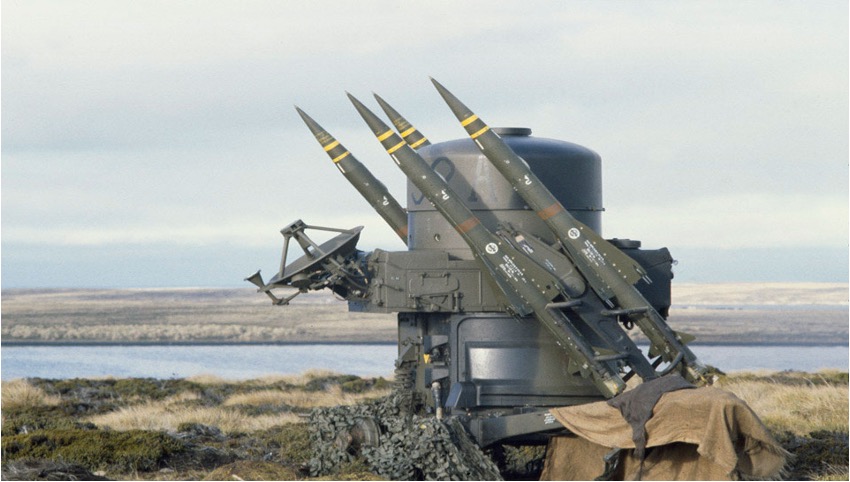
Saturday 22 May
PLYMOUTH has been given the task of Air Defence control of San Carlos Water. The troop landings continued. The two assault ships, FEARLESS and INTREPID, the five LSLs and RFAs FORT AUSTIN and STROMNESS remained in San Carlos Water. Of the original escort ships, only PLYMOUTH, BRILLIANT, YARMOUTH and ARGONAUT (damaged) remained in direct support. The sunk ARDENT’s place was taken by ANTELOPE.
During the day, attempts were made by members of the Royal Engineers to defuse the unexploded bombs onboard ARGONAUT. Although one was successfully defused, the one that had lodged in her SeaCat magazine was proving more difficult and it was postponed until a later time. Regrettably, this bomb had killed both the sailors who were on watch in the magazine at the time of the attack. The ship was eventually able to raise steam and power and moved further into San Carlos Water to a less exposed position.
Bad weather over Southern Argentina reduced the intensity of air raids from the previous day although several raids did get through, mainly by Mirage 3s and A4 Skyhawks, despite the Combat Air Patrols (CAP) from the Carrier Group and the Rapier sites that continued to be set up around the beachhead.
At approximately 1800, the army units ashore reported an enemy submarine that had been sighted in a bay to the south of our position and a Sea King helicopter was despatched to investigate. PLYMOUTH was sailed to engage the submarine. If we found her and we were now in a very exposed position in Falkland Sound, COVENTRY and BROADSWORD are stationed to the North of the Entrance to the Sound to neutralise the air raids. They are the only type of warship in the task force that is safe there, but only when together. As we neared the position, an Air Raid Warning ‘Red’ was sounded and we made a hasty retreat to the safety of San Carlos Water. On the way back, we passed all that was left of ARDENT which was her mast section – like a monument.
The air raid concentrated their attack on the landing ships still in San Carlos but fortunately was unsuccessful. From the carnage that had been wrought the previous day, there was little or no damage to any shipping from the day’s air raids. This was to be the 2nd evening without any air raids, and it was becoming evident the Argentinians had no night flying capability. This allowed the warships to operate in relative safety, with even nighttime operations done in Defence Watches, not Action Stations.
That evening, PLYMOUTH was tasked to insert a small group of SBS personnel behind the Argentinian lines to destroy an airstrip. However, the airstrip was classed as being too close to civilian buildings and the sortie was cancelled.
Sunday 23 May
As the air supremacy battle was slowly being won, the destroyers and frigates of the Task Force continued to escort the transport ships into San Carlos and protect them while they were in there. Another day of clear weather, and the ship continued with what was to become a standard procedure for the foreseeable future – Action Stations at 1045. The transfer of stores and personnel continued, and we were now able to envisage some of the difficulties the troops would encounter ashore – even camouflaged dumps of stores and weaponry would be difficult to conceal because of the very barren and open land which covered most of the Falklands.
The Sound between East and West Falkland was now virtually empty of ships – many lessons had been learnt from the carnage of 21st May. Our major missile ships, COVENTRY and BROADSWORD were situated in ambush positions to the north west of San Carlos Water. In San Carlos Water itself, three frigates, PLYMOUTH, YARMOUTH, and ANTELOPE were protecting the northern end of the Water with the damaged ARGONAUT being joined by ARROW at the southern end, with Rapier missile sites all around the surrounding hills.
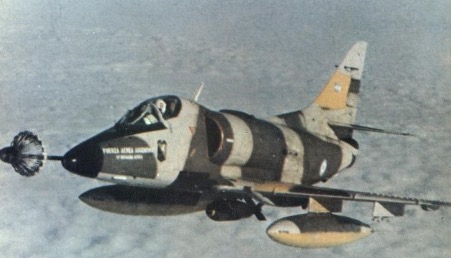
The clear weather brought with it several heavy air raids. The first raid in the early afternoon was by four A4 Skyhawks that struck ANTELOPE, putting two UXBs into her. Again, the bombs did not explode, and their failure was becoming a regular occurrence – the attacking aircraft were releasing their bombs too low for the arming pins to activate the bomb’s warhead. Fortunately for several ships in the Task Force, their failure to explode was a major factor in winning this battle – although the BBC, once again, did not do the Task Force any favours by reporting this fact! The aircraft that were attacking ANTELOPE were coming in so low that one aircraft reportedly struck her mast. The other escorting ships in San Carlos reported several near misses, BRILLIANT being bracketed by 3 bombs all narrowly missing.
The Argentinian Air Force however, continued to suffer a huge attrition rate of aircraft and it was becoming obvious that they could not keep up that rate of loss without a major re-think of their strategy.
At 2030 that evening, it was reported that one of the UXBs on ANTELOPE had exploded. Fortunately, the crew had gone to Emergency Stations on the Fo’c’sle and Quarterdeck and suffered very little casualties. However, the Bomb Disposal Engineer was killed instantly. PLYMOUTH, who had only just left San Carlos Water to carry out night duties around the area, returned to aid if required. By the time we reached her she was a horrible sight. A huge explosion had almost ripped out most of her port side aft and the whole midships area was ablaze with flames leaping high into the air and lighting up the whole bay. Numerous explosions followed and her crew were forced to abandon ship. Thankfully all personnel were clear when a huge explosion, probably from within one of her magazines, almost ripped her in two. At one stage it was planned for a demolitions team from PLYMOUTH to attempt to blow her anchor cable and allow her to drift ashore, but this plan was cancelled. Eventually she was left to burn out and it was not until 1400 the next day that her back was finally broken, and she split in two and sank in shallow water, her bows defiantly remaining out of the water for a further day.
Monday 24 May
PLYMOUTH, YARMOUTH and ARROW formed a barrier to the north of San Carlos Water, with the LSLs and RFAs to the south continuing to land troops ashore. NORLAND returned for a major stores and logistics landing. ARGONAUT, still with her UXB was at the far end of San Carlos providing air defence. FEARLESS and INTREPID still remained inside the frigate barrier. The weather again was perfect with clear blue skies and very little wind.
A morning air raid did not reach the anchorage. Under BROADSWORD ‘s direction, two Sea Harriers bring down three of the Daggers with Sidewinder missiles. A major air raid began in the early afternoon, the anchorage being attacked by A4 Skyhawks and Daggers. The LSL’s Sir LANCELOT and Sir GALAHAD each received a UXB and a glancing blow from a bomb hit Sir BEDIVERE. YARMOUTH was despatched to the south of San Carlos Water to provide more support. The three aircraft in this raid were reported as damaged, including claims by FEARLESS and ARGONAUT’s Seacats, and another crashed into King George Bay on West Falkland on the way home.
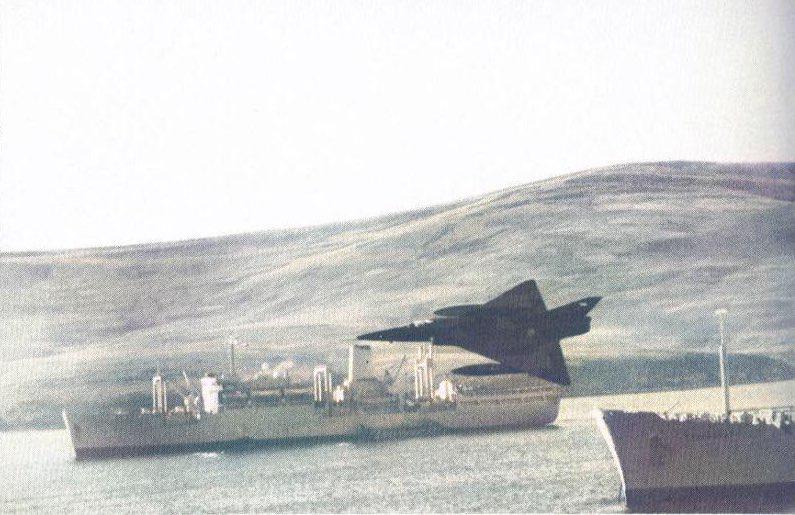
At 2230 that evening, PLYMOUTH conducted a ‘Burial at Sea’ for two sailors who had been killed in the SeaCat Magazine when ARGONAUT had been attacked 3 days previously. With only dim red lights illuminating the Quarterdeck, and except for watch keepers, almost all of the ships company were in attendance as both bodies were committed to the sea in a very moving ceremony. From the Captain downwards, almost everyone had tears streaming down their faces. It was a very ‘quiet’ ship that night. We then proceeded to RV for another RAS.
Tuesday 25 May
Action Stations at 1030 and the Task Group was at a very high state of readiness – this was Argentina’s National Day. Although the Argentines had suffered a great number of aircraft losses, it was believed that a final act of defiance could be expected from them – it was not a misplaced expectation.
The first air raid that morning appeared to be against the two missile trap ships, COVENTRY and BROADSWORD to the north west of San Carlos Water, but COVENTRY’s Sea Dart brought one of the aircraft down at long range and the raid was abandoned.
At midday, a four aircraft raid reached San Carlos Water. One of the aircraft was blasted from the sky by small arms fire and missiles (a claim by YARMOUTH’s Sea Cat) and another was destroyed to the north east of Pebble Island by a Sea Dart from COVENTRY. Shortly after that raid, PLYMOUTH suffered her first damage, albeit self-inflicted. A fire in SC Sonar Compartment was closely followed by another fire in 2J CRO. Both were quickly extinguished.
However, later that afternoon the Argentines conducted a number of major air raids with devastating effect. In a very well-planned raid, four A4 Skyhawks closed from the west. They all appeared to be heading for San Carlos Water and COVENTRY, acting as CAP Controller, warned the Sea Harriers to defend the anchorage. With air cover now gone, the attackers changed course and launched a concentrated attack on the two missile ships. BROADSWORD’s Sea Wolf system ‘broke contact’ with the first two aircraft and she was hit by a bomb that bounced through her stern and badly damaged her Lynx helicopter.
The second pair of Skyhawks then attacked COVENTRY, putting three bombs into her. Within half an hour she had capsized and had been abandoned, with the loss of 19 men. The survivors were picked up by BROADSWORD and by helicopters from San Carlos.
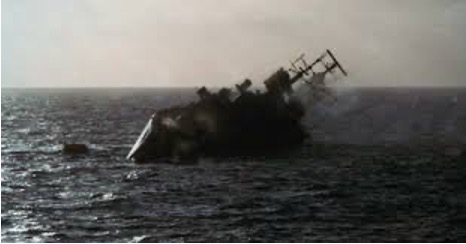
It was later reported that in the confusion of the air attack, both ships had ‘got in the way’ of each other resulting in their Sea Wolf systems breaking contact with the incoming aircraft leaving them virtually undefended.
As COVENTRY was sinking, and in a quite separate raid, two Super Etendards attacked the Carrier Battle Group some 90 miles to the north-east. Both aircraft launched Exocet missiles from 30 miles away and one of the missiles struck the aircraft support ship ATLANTIC CONVEYOR and she was set ablaze uncontrollably. BRILLIANT and ALACRITY both closed to help her, but she was soon abandoned with the loss of twelve men including her Captain (and our colleague Chief Writer Ted Flanagan). The loss of ATLANTIC CONVEYOR was a devastating blow to the whole campaign. Fortunately, the Harriers she was carrying had been flown off shortly before she was attacked. But all her helicopters (six Wessex, three Chinooks and a spare Lynx) and thousands of tons of stores including ammunition, Harrier spares and tents had to be left on the burning ship. She finally sank two days later.
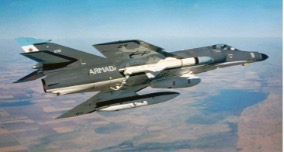
Overnight PLYMOUTH conducted a night insertion of SBS and conducted Naval Gunfire Support around Fox Bay on West Falkland. A total of 176 shells were fired that night into enemy positions and the mission was completed albeit with some difficulty! (see next day).
Wednesday 26 May
The day began with a difference – Action Stations at 0515.
The SBS team and NGS spotter had gone ashore in our Sea Rider, had lost the propeller during the return journey and were now attempting to paddle the boat back to the rendezvous position. In a scene reminiscent of a James Bond movie, the ship closed the shore to recover them. We were illuminated by enemy fire control radar but eventually managed to recover the team at 0700 from under the noses of the enemy, leaving the area at high speed to return to San Carlos Water.
Another group of warships, led by the Type 82 destroyer BRISTOL, had also joined the Task Force, making up for some of the ships lost or damaged. It comprised of CARDIFF, ACTIVE, AVENGER, MINERVA, PENELOPE and ANDROMEDA.
It was a very quiet day in San Carlos Water and this turned out to be the first of many quiet days – the air supremacy battle had almost been won. Despite numerous Air Raid Warnings RED, no aircraft approached the anchorage. We were able to operate at relaxed Action Stations and passageway hatches were only on 2 clips so we could walk around a little more, even spending time on the upper deck.
Thursday 27 May
Another quiet day in San Carlos. Action Stations at 1045 (this was now a daily ritual). It was not until 1930 that evening when the calm was broken by an air raid against positions at the bridgehead – this was the first of its kind in San Carlos Water. The four aircraft raid concentrated on the area surrounding the field hospital and resulted in 5 casualties.
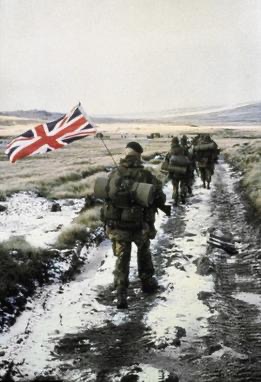
The battle for the re-capture of the Falkland Islands was now concentrated on the land forces and the ship began to receive reports that our forces were closing enemy position at Darwen and Goose Green. We also received a report that a Sea Harrier had been attacked near Goose Green and the pilot had to eject behind enemy lines.
Friday 28 May
Another quiet day in San Carlos Water! The weather was very overcast. First reports being received of successes by 2 Para at Darwen.
Saturday 29 May
San Carlos Water had become a very ‘safe’ place to be with no enemy attacks taking place.
At 1450 came reports that 2 Para had finally overcome very strong Argentinian resistance and had re-captured both Darwen and Goose Green, taking over 1400 prisoners with over 150 Argentinians killed. But it was not without British losses – 15 men, including their CO, from 2 Para, 2 other fatalities and approximately 35 paras wounded. The civilian population of both settlements (approximately 100) had been held ‘prisoner’ in a church hall for almost 3 weeks. 2 Para also found large quantities of Napalm – a lethal weapon for use against ground forces that had been universally outlawed after the Vietnam War.
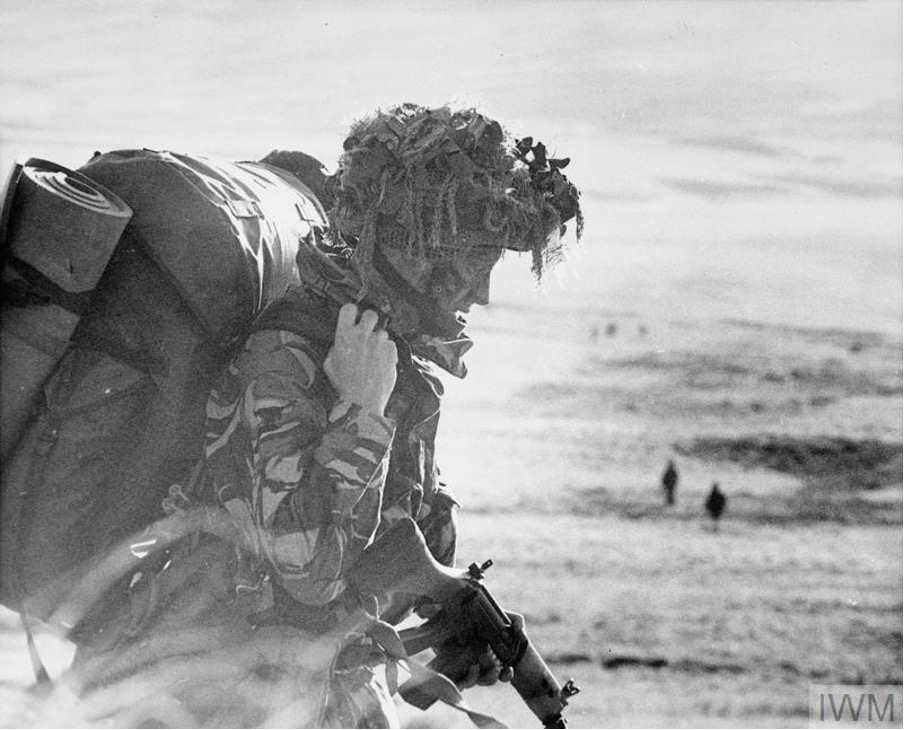
The Sea Harrier pilot who had been forced to eject on 27 May was also found safe and well having managed to evade capture for 2 days.
Sunday 30 May
PLYMOUTH now headed away from San Carlos Water towards the main CVBG (Carrier Battle Group) for what was supposed to be a couple of days well-earned rest!
At 1640, the ship went to Action Stations due to a possible Exocet attack. This was very quickly reported as a misident on a Super Etendard radar signal and we were stood down. However, at 1730 we were again closed up as the Air Raid Warning went RED based on EXETER, who had recently joined the Task Force, reporting three Super Etendards approaching the CVBG.
At 1742, 2 Exocet missiles were reported has having been launched. All ships in the group immediately fired Chaff – a major missile confusing defence against Exocet and fortunately both missiles missed all of the ships in the group. EXETER reported bringing one missile down with Sea Dart and AVENGER reported bringing one down with her 4.5″ gun – never confirmed. EXETER also claimed two hits against the attacking Etendards.
At 2225, the ship again went to Action Stations when another Super Etendard radar was picked up. As no missiles were fired it was assumed that this may have been the third aircraft from the day’s earlier raid that had possibly landed at Port Stanley and had now commenced its journey back to the mainland.
This was proving not to be a very safe place to find yourself and the whole ships company longed for the relative safety of ‘Bomb Alley’!
Monday 31 May
The day was spent in the company of the CVBG. It had been intended to conduct a major RAS(S) with FORT AUSTIN, but the weather was against this, and it was postponed for 24 hours. With no air raids, the ship continued providing ASW cover for INVINCIBLE.
Tuesday 1 June
The main event of the day was a large RAS(S) with FORT AUSTIN embarking further stocks of ammunition and a small quantity of food. On completion of the RAS, PLYMOUTH began escorting the amphibious ships back into San Carlos Water. They were now carrying most back-up forces for the continuing land battle – the 5th Infantry Brigade comprising of the Welsh, Irish and Scots Guards and the Gurkhas. PENELOPE picked up 2 Para’s new CO after he had parachuted into the sea from an extended range Hercules on a flight from Ascension Island!
From ashore came reports that the land forces were continuing to consolidate positions nearer to Port Stanley with 42 and 45 Commando and 3 Para around the Mount Kent and Two Sisters areas. Late that morning, MINERVA, in San Carlos Water supporting the landings, detected an Argentinian Hercules on a reconnaissance mission. Our CAP was informed, and a Sea Harrier brought her down 50 miles north of Pebble Island using Sidewinder and cannon fire.
Wednesday 2 June
PLYMOUTH was again in San Carlos Water providing support and protection to the largest gathering of ships since 21 May as the major elements of the 5th Infantry Brigade were put ashore. They included FEARLESS and INTREPID, NORLAND, BALTIC FERRY, NORDIC FERRY, ATLANTIC CAUSEWAY and once again, CANBERRA who, after offloading her troops, left the area for the remainder of the war.
Once again, weather was on our side with very low cloud cover for most of the day allowing the landings to take place unhindered. CARDIFF attacked a sub-surface contact and reported that she had heard a large explosion but could not confirm if it had been a submarine. We could now see the Sea Harriers in operation as the Royal Engineers had completed a Forward Operating Base allowing them to land at Port San Carlos.
PLYMOUTH sailed from San Carlos at 2200 escorting the LSL’s on the task of moving troops to a more forward operating base of Teal Inlet to support 3 Commando Brigade.
Thursday 3 June
The day began with a difference – Action Stations was not sounded until 1100. Due to the very bad weather conditions, there were no enemy air raids.
Reports from ashore confirmed that the troops were progressing even better than expected. The area around Mount Kent and Two Sisters had now been secured and our forces could now train their artillery on positions in and around Stanley. It was also reported that the resolve of the Argentinian forces was fast diminishing, especially as they now know that we do take prisoners – further reports had indicated that the Argentinian commanders had informed their forces that the British would kill any POWs taken!
One group of 160 surrendered to a force of 16 SAS; four to a passing Sea King; and four surrendered to one soldier who had gone to collect water early in the morning!
A Vulcan raid on Stanley airstrip also took place although the success of this operation was unknown as the pilot was forced to land in Brazil.
Friday 4 June
Another very quiet day in San Carlos Water, the weather being even worse than before with very low cloud, mist and rain.
From ashore, 2 Para were helicoptered 35 miles from Goose Green to occupy the two settlements of Fitzroy and Bluff Cove that had been reported clear of the enemy by a telephone call made by the CO of B Coy 2 Para!
At approximately 1900, an air raid by 6 Canberra’s closed from the east but bypassed San Carlos Water and concentrated their raid in Berkeley Sound, just to the north of Port Stanley. There were no reports of casualties or damage to our forces, but one pilot was heard to say that he was running out of fuel and he still had the return journey to make back to the Argentine mainland. PLYMOUTH engaged one of the returning Canberra’s as she made her journey back home but it was unlikely to have been hit.
That night, PLYMOUTH conducted ASW (anti-submarine warfare) patrols in Falkland Sound.
Saturday 5 June
Another quiet day in San Carlos Water. Despite numerous Air Raid Warnings RED, none materialised over the area. During one period at Air Raid Warning RED, very little was heard between decks of the impending raid. Five minutes became ten minutes became about fifteen minutes with no reports from the Bridge of what was happening. The silence was broken by the witty comment ‘What are they coming in, f……g Hang Gliders?’. I’ll never forget that moment.
During the night, it had been intended to conduct NGS against enemy positions around Port Howard. However, on arrival in the area, we discovered that an Argentinian Hospital Ship was in the area so the NGS was cancelled. The remainder of the night was spent patrolling Falkland Sound. Other naval movements that night were necessary to support the successes of the land forces. Elements of 5th Infantry Brigade had to be brought forward by sea to support 3 Commando Brigade. That night, INTREPID carried a battalion of Scots Guards to Bluff Cove and her LCUs transferred 3 Coys of 2 Para already there to Fitzroy.
Sunday 6 June
This was now beginning to feel like ‘Groundhog Day’. Another quiet day in San Carlos Water with Action Stations at 1100. Dull and foggy conditions allowed a more relaxed regime between decks and we were allowed to move freely around the ship taking in some hastily arranged keep-fit sessions on the flight deck. Overnight, PLYMOUTH conducted escort duties and ASW patrols.
Several incidents in the transfer of our forces to forward operating bases were to have a profound effect on PLYMOUTH in the days to come.
A plan to improve communications links between the bridgehead at San Carlos and Bluff Cove was thwarted. An AAC Gazelle carrying two Royal Signals engineers to set up a relay station was accidentally shot down near Pleasant Peak by a Sea Dart fired by CARDIFF, killing all four onboard.
FEARLESS also attempted to transfer the Welsh Guards to Fitzroy. However, as only two of her LCU’s were available, she was only able to land HQ and 2 Coy into Bluff Cove. The rest had to be brought back to San Carlos Water to try again on Monday night.
Monday 7 June
PLYMOUTH was in San Carlos Water yet again and Action Station at 1100. The weather was fine and clear.
An air raid was detected at 1200, with two aircraft reported closing at 130 miles. EXETER, also in San Carlos Water, fired 2 Sea Darts as the aircraft closed to 29 miles. One missile was ‘rogue’ but the other hit one of the aircraft at 29,000 feet. The other aircraft in the raid immediately turned and departed rapidly back to the mainland.
Although there were no more raids above San Carlos Water, the forces ashore reported that they had been attacked by four A4 Skyhawks – three were reported as destroyed by Rapier missiles. The night was spent patrolling to the southern end of Falkland Sound.
The other operations were to have an, as yet, unknown profound effect on PLYMOUTH. It had been decided to use the LSL ‘s to continue 5th Infantry’s Brigades move forward. SIR TRISTRAM reached Fitzroy today to offload ammunition and in San Carlos Water the remainder of the Welsh Guards was transferred from FEARLESS to Sir GALAHAD for an overnight journey to Fitzroy to arrive next morning.
Tuesday 8 June – They finally got us!!
The day began quietly enough in San Carlos Water – we had sailed in early morning and anchored in what had become our usual spot. It was a beautiful morning, water like glass and not a ripple to be seen. Action Stations at 1100; Action Messing (as usual) at 12 noon. It was always a rushed affair and everyone onboard had eaten and back at Action Station by 1230.
It was a relaxed atmosphere throughout the ship as air raids into Bomb Alley were now rare. As the Reg Office was in the immediate vicinity of my Action Station, I was keeping busy by typing up some reports.
However, it was to be the day for the Argentinian Air Force to make one final effort to alter the course of the war.
Elsewhere, at Fitzroy, the plan to offload the Welsh Guards had come to nothing with only one LCU and a Mexefloat available to move the Guardsmen. Worse still, the LSL’s had been spotted by enemy observers and the Argentinian Air Force were to launch their last major attack of the war.
At 1630, PLYMOUTH was ordered to proceed into Falkland Sound in support of an SAS patrol on Mount Rosalie on West Falkland who had spotted activity from the observation post which was just opposite the entry to San Carlos. They had requested NGS support to destroy it.
At 1645, HERMES reported a possible air raid heading towards the Falklands.
At 1700, we had arrived opposite Mount Rosalie and we believed we had about 10 minutes to fire at the observation post before returning to San Carlos.
At 1705, our Ops Room identified 5 Mirage Vs were heading up Falkland Sound. Everything happened so quickly, but vivid memories of the next few hours.
Hit the Deck; Hit the Deck!!
I leapt out of the Reg Office, with the LReg following me out of the door into the Burma Way, landing on top of me. In their first pass, the aircraft attacked us with 30mm cannon shells, and they were dropping white hot directly in front of us. They were causing untold damage throughout the ship but the worst was yet to come. The aircraft circled for a bombing run.
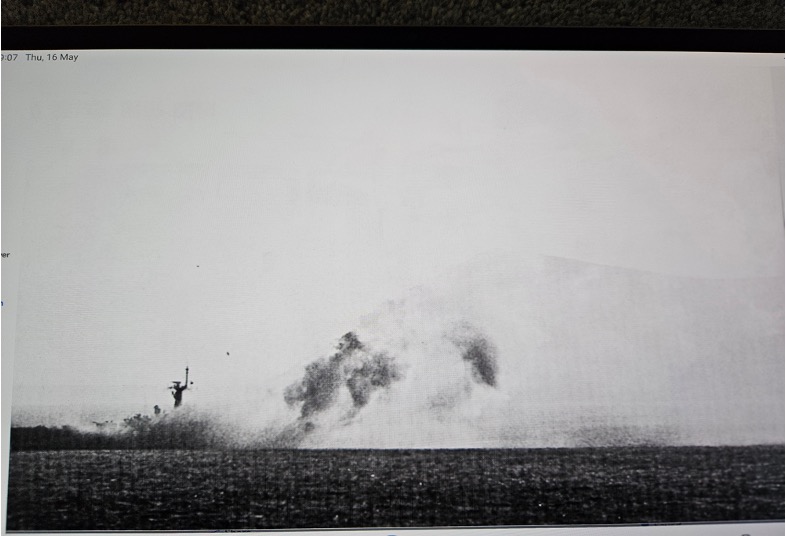
Our 4.5” gun had been put out of action during the first attack. We had a secret laser mounted on the bridge roof, but the Buffer who was operating it couldn’t get the laser round far enough to be of any use to us. The aircraft hit us with 4 1000lb bombs and it was a miracle that none of them exploded. The BBC had reported early on following previous bombs not exploding that the aircraft were launching them too low and the firing pins didn’t have enough time to arm the bombs. The BBC yet again letting down the UK forces.
Still firing 30mm cannon shells, 2 bombs went straight through the funnel, 1 bomb went straight through the Mortar Bomb Handling Room, hitting one of our mortar bombs. It then continued its passage through the bulkhead and bounced off one of our mortar bomb launchers causing considerable damage before crashing into the sea. The 4th bomb hit a depth charge that was lying on the flight deck that imploded into the After POs Mess and the Senior Rates and Junior Rates Dining Rooms and a major fire broke out. I remember thinking I’d been hit, but it was PO Bobby Campbell that had run past me and had accidentally kicked me in the neck – his arm had been broken by the force of the POs mess door being flung into the Burma Way. The Sick Bay was in the immediate vicinity so was now out of action.
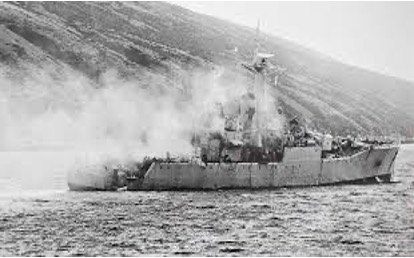
The ship was now returning to San Carlos Water at high speed – we must have been some sight coming into Bomb Alley at speed trailing thick black smoke from the funnel, flight deck and quarter deck. We anchored in our usual spot as we fought the fires in the starboard quarter. AVENGER came to our aid with additional firefighting equipment and PENELOPE approached to give us air cover as the raid was still Red. The After POs Mess was well ablaze, as were both Dining Halls. A couple of messdecks immediately below were flooding with the amount of water being used to both fight the fire and boundary cool the surrounding bulkheads. The fire was being fought with great skill and courage for almost 2 hours by our own firefighting teams and they managed to contain the fire within the Mess and Dining Halls, which were totally destroyed.
We had suffered 5 casualties during the attack, fortunately none of which were fatal. Jack Warner was the most serious as he had a piece of kick out panel retaining clip in his skull just above his eye, Bobby Campbell had his broken arm, George Donkin had shrapnel in his knee in the Gun Turret attack, Chris Savin had a leg injury and Jimmy Riddock a head injury. Dusty Miller suffered smoke inhalation from fighting the fire but recovered quickly.
We had set up the Wardroom as the Emergency Sick Bay and additional medical support had been flown onboard very quickly. The casualties were all evacuated from the ship by air, but the helicopter pilots had to, very skilfully, land their aircraft on the guard rails of the foc’sle as the flight deck was out of action. Apart from Jack, who we managed to move by stretcher from the Wardroom, up the starboard waist and onto the foc’sle, all the others were walking wounded.
Had any of the bombs exploded, especially the one that entered and exited the Mortar Bomb Room, it is doubtful if the ship would have survived. We had been very lucky.
While all this was happening, the aircraft had continued onto Fitzroy. Three of them put two or more bombs into the crowded SIR GALAHAD, and the other two hit SIR TRISTRAM with two UXBs killing two crewmen. Both ships had caught fire and were soon abandoned, but by then the results for Sir GALAHAD had been catastrophic with a total of 48 killed, five RFA crewmen, 32 Welsh Guards and eleven other Army personnel, with many more badly burned or wounded.
SIR TRISTRAM was later to return to the UK for repairs, but the burnt-out SIR GALAHAD was to be scuttled at sea as a war grave later that month.
Later that evening, Bomb Disposal experts arrived to defuse a mortar bomb that had been damaged and was in a dangerous condition trapped inside a damaged tube. PLYMOUTH went to Emergency Stations, the ship’s company mustering on the foc’sle. Despite being aware of the danger we were in, if the mortar bomb exploded the likelihood was that the back end of he ship would be blown up and we’d probably sink, and what must have sounded very strange to other ships in the anchorage, we broke into loud song and gave rousing renditions of ‘The Northern Lights of Old Aberdeen, ‘On Ilkley Moor baht at’, and favourite sailors songs. Defiance!!
The bomb was eventually safely defused. To this day, I can’t remember going to bed that night or recall anything after emergency stations.
Wednesday 9 June
That night, PLYMOUTH left San Carlos Water at 2200 and sailed towards the CVBG and the repair ship STENA SEASPREAD.
Thursday 10 June
Now with the CVBG, PLYMOUTH conducted a RAS(L) and then proceeded further east to rendezvous with STENA SEASPREAD at 1700. We did not go alongside her, as thought would first happen, but sat about 200 yards from her. The repairs commenced at 1730 and continued non-stop until 1300 on Sunday 13 June.
Friday 11 June – Saturday 12 June
PLYMOUTH remained under repair. Elsewhere, the land forces were continuing to close on Stanley and are engaged in battles for positions that were to become well known to everyone later on – Mount Harriet, Wireless Ridge, Mount Langdon and Tumbledown Mountain.
On the evening of 12 June, the main assault on Stanley began in earnest. Four ships, ARROW, AVENGER, YARMOUTH and GLAMORGAN, all carried out NGS on enemy position and all were successful. Unfortunately, early on the morning of 12 June, GLAMORGAN sustained a direct hit by a land-based Exocet missile and suffered 13 fatalities with another 12 seriously injured. She made passage under her own power and came alongside STENA SEASPREAD at approximately 2300 that night.
Sunday 13 June
The ship left STENA SEASPREAD at 1300 and proceeded to join the main CVBG. At 1900, it was reported that a possible Exocet attack could be under way. However, the closing aircraft turned back for the mainland. PLYMOUTH spent the remainder of the night in company with the CVBG.
Monday 14 June
The day began with a RAS(S) quickly followed by a RAS(L). Early that afternoon, PLYMOUTH and YARMOUTH were despatched to proceed to the northern gun line in Berkeley Sound as the forces ashore had made remarkable advances and required gunships to be in position by midnight to carry out NGS on enemy positions in Port Stanley.
During the transit to the area, the Captain informed the ship that reports were being received that the enemy forces in Stanley were beginning to surrender. As more reports were received, it became clear that the whole Argentinian garrison in Port Stanley had surrendered and the major battle had been won. PLYMOUTH and YARMOUTH continued into Berkeley Sound, arriving at 2230. Due to the possible threat that may still have existed we remained at Action Stations.
Tuesday 15 June
Still at Action Stations, the Captain informed the ship that the official surrender had taken place at 0100 and included all enemy forces on the islands.
THE FALKLAND ISLANDS WERE, ONCE AGAIN, UNDER BRITISH CONTROL.
PLYMOUTH and YARMOUTH left Berkeley Sound at approximately 0330 to rejoin the main CVBG. Unfortunately, the weather turned very nasty and an extremely rough passage was made in the most inhospitable of Southern Ocean seas. At one point the ship rolled 35 degrees to port and our speed was reduced from 21 knots to 11 knots. We met up with the CVBG later that afternoon and a very uncomfortable night was spent bouncing around on the continually rough seas. I also finally got a bunk space in the Chiefs Mess – 3 months after being promoted!!
Wednesday 16 June
After a RAS(L) with OLMEDA, PLYMOUTH was once again detached from the CVBG and proceeded back towards the islands. A naval presence was required in Port Stanley Harbour and PLYMOUTH’s Captain was to become Acting Queen’s Harbourmaster Port Stanley until suitable arrangements could be made ashore. The remainder of the day was spent in passage to Port William, the outer harbour of Stanley.
Thursday 17 June
A large number of ships had now arrived in Port William – CANBERRA, EUROPIC FERRY, ATLANTIC CAUSEWAY, NORDIC FERRY, FORT TORONTO, CONTENDER BEZANT, ST EDMUND (with our mail), TOR CALEDONIA, TYPHOON, SIR BEDIVERE, SIR PERCIVALE, RFA RESOURCE and the Argentinian Hospital Ship BAHIA PARIASO.
A party from PLYMOUTH boarded the hospital ship and conducted a search as she was suspected of operating out with the Geneva Convention for Hospital Ships. This was unfounded and she was correctly a hospital ship.
At 1200Z (0800 local time) and after our minesweeping trawlers (CORDELLA, FARNELLA and JUNELLA) had successfully cleared a field of contact mines laid off Cape Pembroke, PLYMOUTH became the first British vessel to enter Port Stanley since the Argentinian invasion of 2 April. This was to complete a remarkable treble for the ship – involved in the first operation of the war at South Georgia, she had become the first ship into San Carlos Water during the landings of 21st May and she had now become the first ship into Port Stanley. The ship anchored off Public Jetty and the citizens of Port Stanley were treated to a ‘Victorious Fly Past’ by a squadron of Sea King helicopters, much of it for the benefit of TV crews.
A small Argentinian oil rig tender, YEHUIN, was lying alongside at Stanley and had to be moved by a party from PLYMOUTH under the command of our First Lieutenant. The ship’s company re-named her ‘HMS OGGIE’ but she was later officially renamed ‘FALKLAND SOUND’.
The Captain also announced today that PLYMOUTH was to be released from operations in the area and was being allowed to return home.
Friday 18 June
PLYMOUTH left Port Stanley at 0815 and returned to her old ‘stomping ground’ in San Carlos Water where the repair ship STENA SEASPREAD had arrived. Over the next two days, we received minor repairs to a leaking patch and, while waiting for GLAMORGAN who was to be our partner as we both limped on the long trip home – a number of the ship’s company were able to go ashore for a leg-stretch in the surrounding hills.
Saturday 19 June
That evening, PLYMOUTH left San Carlos Water for the last time and, in company with GLAMORGAN, rejoined the main CVBG for a further 24 hours.
Monday 21 June
After final transfers and RAS(L)s, PLYMOUTH and GLAMORGAN steamed past the CVBG in line astern to give a final salute to the Task Force Commander. In a colourful display of smoke and sound effects, both ships were given a rousing send off by the crews of the CVBG, led by HERMES.
At 1300, both ships began their passage north, our part in OPERATION CORPORATE complete.
As we left the Task Force, a number of signals were received onboard acknowledging our part in the re-capture of the Falkland Islands.
From Flag Officer First Flotilla – “Your dash, perseverance and infinite patience in the face of extreme danger inshore has made a vital contribution to the success of the operation. Go home with pride in the knowledge of a job well done, enjoy a well-earned break and reassemble the bones of a grand old lady.”
From Commander in Chief Fleet – “I am most impressed by the way you have recovered from air attack damage and relieved that you suffered so few casualties. You have had a long, hard and varied role in this operation for which you can be very proud. Well done and safe passage home.”
From Commodore Amphibious Warfare – “From the early days shepherding LSLs, through D-Day, Bomb Alley and Naval Gunfire Support to setting up Port William, have come to rely on you as thoroughly dependable right-hand man. Your ability to break through and keep on charging has been an inspiration to us all. Indeed, it is that very ability which keeps you here when some might have limped away. Very best wishes for a safe landfall, well earned leave and future operations.”
From HMS ANTRIM – As an ex-member of the South Georgia Club, we have followed your doings with admiration. Well done on your accomplishments. Bon Voyage and Happy Homecomings.
Additional Note – Captain David Pentreath, DSO, CBE, CO of HMS PLYMOUTH during the Falklands conflict, died after a stroke on June 26, 2019, aged 86. In his Obituary in ‘The Times’, Captain John Coward, who commanded HMS BRILLIANT during the Falklands, said of Captain Pentreath:
“Of course Plymouth was always going to cop it. She did not really have the right kit to fight these kinds of action. But I’ll never forget her in San Carlos Water when we were under such serious attack — she just steamed round and round the other ships in a gesture to the Argies of total defiance. She had comparatively little to fight with, just guns and an old Sea Cat, but she gave it everything.”
He added: “Pentreath? Bravest chap I’ve ever seen.”
Our 16 day journey home was the exact opposite of Defence Watches and we had some great afternoons on the flight deck enjoying the sun – and the beer! We landed an Advance Leave Party in Ascension Island and King Neptune paid his visit and welcomed us as we crossed the Equator.
The journey home was broken with an unforgettable 3-day visit to Gibraltar, continuing our series of firsts – this time the first ship to enter Gibraltar on the way back from the Falklands. The Gibraltarians give us a spectacular welcome and a very good time was had by all!
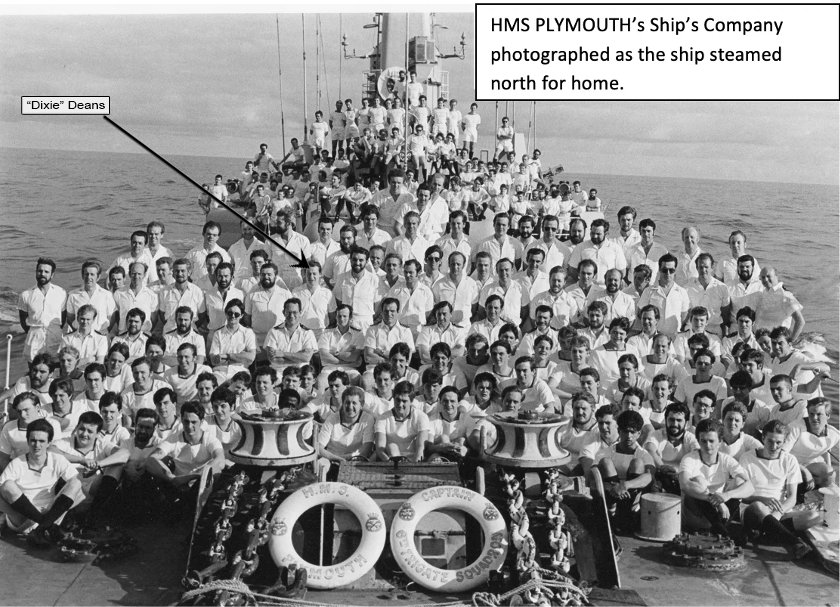
Tuesday 13 July
PLYMOUTH had arrived in the Forth Estuary and anchored overnight in Burntisland Bay. The Advance Leave Party rejoined by tender. This meant that everyone else onboard could enjoy the following day that was to come and the excitement was unbearable.
Wednesday 14 July
PLYMOUTH sailed into the Forth Estuary to a hero’s welcome. Cheering crowds lined the foreshore at North and South Queensferry and hundreds of people lined the Forth Road Bridge where well-wishers had hung a ‘Welcome Home Lads’ banner. The whole of the dockyard had been given time off work to welcome the ship and tugboats sprayed water cannon in salute as a flotilla of small boats escorted the ship towards Rosyth. A lone piper and a Royal Marine band played a welcome.
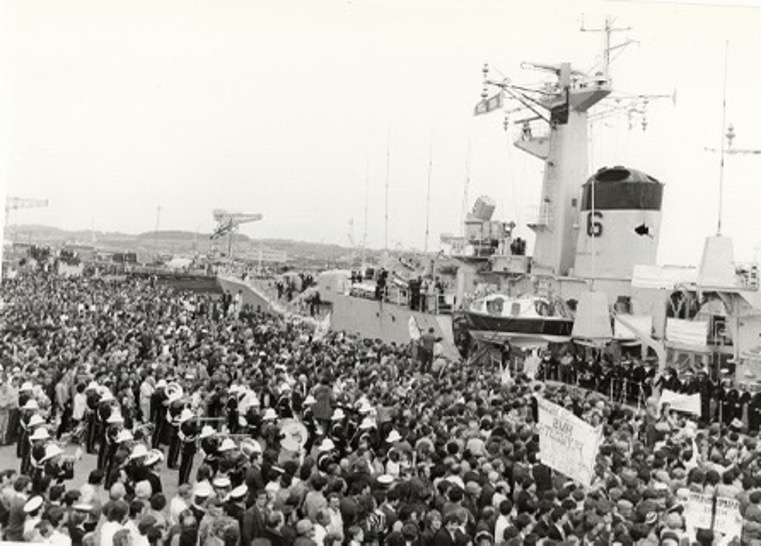
The unforgettable sight of ‘South Arm Jetty’ (above) where our families, wives, children and parents had gathered waving banners to welcome us home was what many of us had prayed for during some of the darkest days and nights.
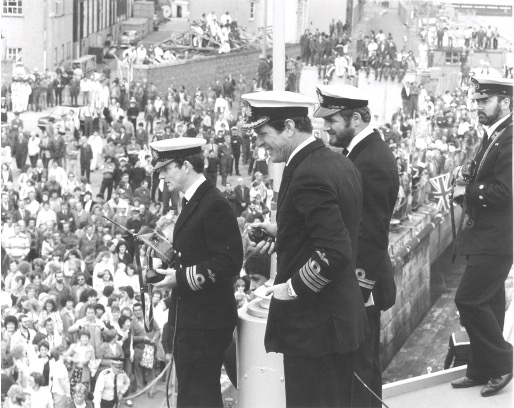
It had been an epic journey of some 34,000 miles to the inhospitable South Atlantic. During the operations, the ship had fired 909 4.5″ shells, mainly supporting the military operations ashore, had fired nine Seacat missiles and shot down five enemy aircraft.
Through our own determination, we managed to keep the ship a fighting unit by refusing to be beaten. We had now safely returned after our daring exploits and amazing escape on 8 June.
It had been an experience that will never be forgotten by all those who took part.
ADDITIONAL NOTES TO THE EVENTS ABOVE
The Surrender of South Georgia – and the ‘famous photograph’ (or simply just having a photograph!!!). The true story…….
That photograph was given many titles, some even saying it was the Surrender of the Falklands. Unless anyone else knows, I’ve never seen a photograph of the actual surrender of South Georgia or the of the entire Falklands. Only this photograph is known.
But this was actually the surrender of the Argentinian Garrison at Leith – albeit the last act of the South Georgia operation. Although Captain Brian Young of HMS ANTRIM (CTG 317.9) was pictured in the photograph alongside Captain Pentreath, the signing of the Surrender of South Georgia took place later that day onboard HMS ANTRIM and signed by the Commanding Officer of S/M SANTA FE, Commander LAGOS, Commander Argentine Land Forces; Captain Young, and Major Sheridan, 2nd in command, 42 Commando Royal Marines.
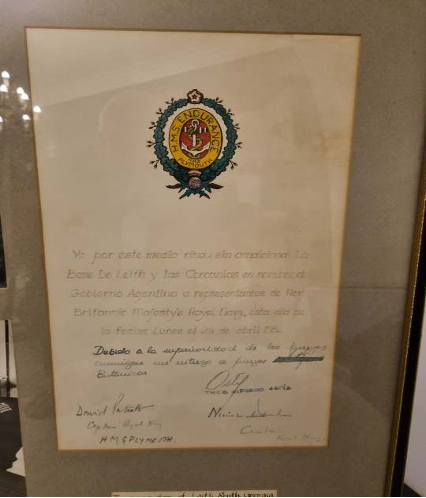
Captain Pentreath was very astute – I found out later from his son, Admiral Jon Pentreath, that his dad only gave a copy of the Instrument of Surrender for official purposes. He believed this would simply be filed away deep in the Ministry of Defence records, so he kept the original document that remains in his family to this day. I’ve attached a photograph of that document, taken a couple of years ago at the Chiefs Mess Annual Reunion when Admiral Jon Pentreath was Guest of Honour.
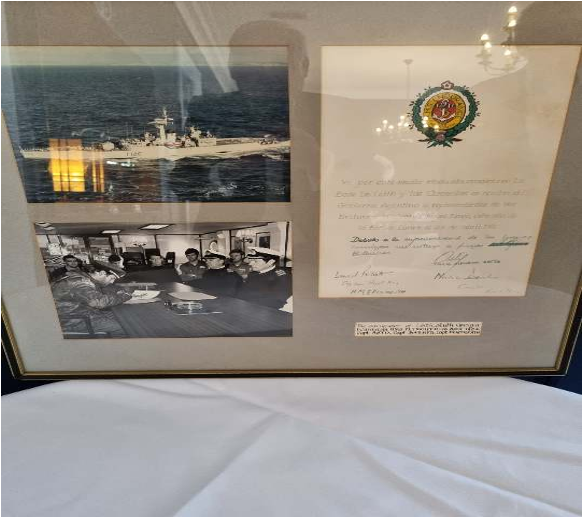
How did I happen to be in the photograph. Well, it must have been around Stand Easy!!
The Ship’s Office was below the CRO and Wardroom Pantry and was on my way back aft to the Chiefs Mess for coffee. The First Lt, Iain Henderson, who himself went onto to become Rear Admiral and Flag Officer Naval Air Command and remains a friend, grabbed hold of me and said I needed to go into the Wardroom. So, in I went……….and the rest is history.
The 1st Lt must have thought a great deal of who would be witnesses to the surrender as it included a CPO (Myself), a PO(EW), a LWEM (who passed away a number of years ago), and 2 ABs (a Steward and another WE).
It was a unique occasion, but I can’t remember realising the importance of such a moment at the time. It was not until some weeks later when we received letters from home that the photograph had become worldwide news and had been the first photograph taken of the whole campaign.
My wife was at my parents’ house in Scotland when it hit the TV news bulletins and she said that my 2 year old daughter ran up to the TV screen and kissed ‘Daddy’. My wife said “at least he could have washed his hair”!!
As another anecdote, both of them were at her own parents’ home in Wigan when the ship was attacked so she had support from her Mum, Dad and family at the time.
JUST ‘SAT’ AT BOST……….
A number of years later, our then 1st Lt was commanding HMS LONDON and had gone for Sea Training at Portland. It was there he discovered that HMS PLYMOUTH’s exploits on that day in June 82 was now being held up as the perfect example of how the firefighting had saved the ship.
FOLLOW UP TO THE BURIAL AT SEA EVENT
Many years later, POPT Clive Todd (our Clubswinger onboard who had led the singing at Emergency Stations when the ship had been attacked) had retired from the Service and was working in Cardiff waterfront for the MV WAVERLEY. He shared his office block with a DIY firm and a couple had come in over lunchtime to see the DIY firm. They were closed and Clive invited them into his office for a coffee. On the wall behind his desk was a photograph of HMS PLYMOUTH and the couple asked him if he had been in the Navy and had he been in the Falklands. Saying Yes, the couple then said that there son had been killed during the Falklands onboard HMS ARGONAUT and their only regret was that they did not know how their son was buried at sea.
Clive asked them to sit down and then told them the full story of that night as we had conducted the burial. Even as I type this, I still get shivers and feel emotional. They were eternally grateful, and Clive said they left his office as though they had the world lifted from their shoulders. I don’t know if that couple were the same as in the next follow up note.
SECOND FOLLOW UP TO THE BURIAL AT SEA
I only found this out in April 2024.
One of the 2 sailors killed onboard HMS ARGONAUT was AB(S) Iain Boldy. On 22nd December 2017, HMS CLYDE, on patrol in the Falklands Islands, conducted a very moving ceremony when the ashes of Iain’s parents, in 2 gun cases, were committed to the deep in the exact same spot as where Iain’s body had been committed in 1982. The ‘Boldy Family’ were finally together again.
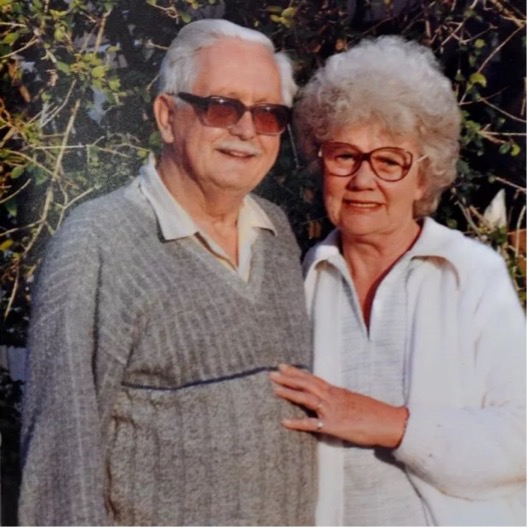
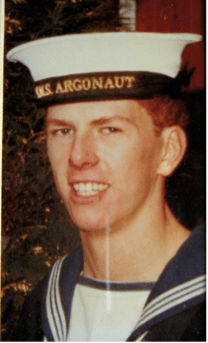
Hope you have enjoyed reading this.
“Dixie” Deans
